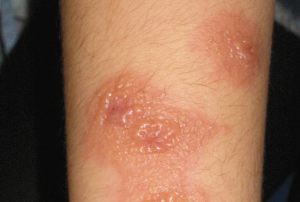Chapter 12: Skin Problems Caused by the Environment
Bites and Stings: Arthropod bites
What are they?
Arthropods are a phylum that includes arachnids and insects. Many arthropods such as mosquitoes, fleas, ticks and flies bite humans as a source of nutrition or as a part of their life cycle. Arthropod bites themselves can also cause significant morbidity, particularly in children, where they can lead to exaggerated reactions with formation of blisters and intense itching. Scratched lesions may become secondarily infected leading to impetigo, abscesses, or cellulitis. It is often difficult to tell the source of the bite based on clinical morphology, but there are a few clues. Bed bug bites typically occur overnight on exposed skin and are clustered. Flea bites are commonly seen on lower extremities, but more widespread on toddlers who are closer to the ground. Mosquito bites are most prevalent on exposed skin, and chigger (larval mites) lesions are most prevalent on covered skin. In endemic areas, arthropods may also carry diseases such as malaria, zika, and dengue that are transmitted by mosquitos, as well as rickettsial illnesses including Rocky Mountain spotted fever (caused by Rickettsia rickettsii) and Lyme disease (caused by Borrelia burgdorferi) that are transmitted by ticks.

How can bites be managed?
Prevention of bites is an important part of management. The approach is multifaceted and can include: use of repellants containing DEET (with concentration less than 10% for use in pediatrics), avoidance of areas where it is clear bites are occurring and treatment of pets for fleas and ticks. Thorough inspection of the household and/or use of professional exterminators should be considered in cases where the bites are suspected to be occurring at home. In terms of the bites themselves, oral antihistamines can lessen the itching and application of a topical corticosteroid mixed with antibiotic ointment can decrease the reaction while preventing secondary infection that may occur after scratching.

